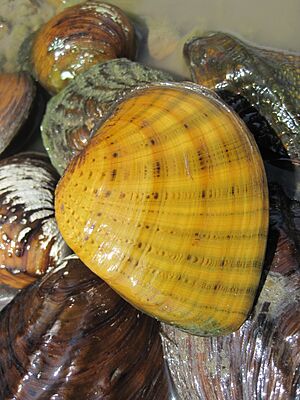Ellipsaria lineolata facts for kids
Quick facts for kids Ellipsaria lineolata |
|
|---|---|
 |
|
| A live individual of Ellipsaria lineolata | |
| Conservation status | |
| Scientific classification | |
| Genus: |
Ellipsaria
|
| Species: |
lineolata
|
Ellipsaria lineolata is a special type of freshwater mussel. It's an animal that lives in water and has two shells, like a clam. This mussel is also known as the Butterfly Mussel because of its shape. It's the only species in its group, called Ellipsaria. You can find these mussels in many rivers across the United States, especially in the Mississippi River, Mobile River, Tennessee River, and Cumberland River. They live in the middle of the country, but also on the east coast and down to the Gulf of Mexico.
What does the Butterfly Mussel look like?
The Butterfly Mussel, or E. lineolata, has a thick shell. It's usually shaped a bit like a triangle with rounded edges. Male mussels have shells that are flatter and longer than female mussels. Males can grow up to about 12.7 centimeters (5 inches) long. Females are smaller, growing to about 7 centimeters (2.7 inches) long.
Most Butterfly Mussels have a yellowish color on the outside of their shells. But older mussels can sometimes be dark brown. The inside of the shell is white. The part where the two shells connect, called the hinge, can sometimes be a dark green color. The shell also has fine, wavy lines near the beak, which is the oldest part of the shell.
How have Butterfly Mussels been used?
In the past, Butterfly Mussels, along with other freshwater mussels, were used to make buttons. These buttons were often called "pearl buttons."
Today, these mussels are sometimes used in the cultured pearl industry. This means they help create pearls that are grown on farms.
Why are Butterfly Mussels in danger?
The Butterfly Mussel is considered to be in serious danger in some states, like Louisiana and Kansas. These mussels live buried in sand or gravel at the bottom of large rivers. They prefer rivers with fast-moving water. They have also been found in reservoirs, which are artificial lakes, in the Tennessee River.
Butterfly Mussels are "long-term brooders." This means they carry their young for a long time. You might find them carrying young at any time of the year.
The main home for this mussel is the Mississippi River basin. However, the conditions in this river system are getting worse. This causes a big threat to the mussels.
- Habitat changes: Things like straightening river channels, building dams, and digging up the riverbed (dredging) block fish from moving freely. These activities also increase silt in the river. Silt is fine dirt that can cover the mussels and make it hard for them to breathe.
- Host fish problems: Butterfly Mussels need a special fish called the freshwater drum (Aplonditus grunniens) to complete their life cycle. If these fish can't move around because of dams, it hurts the mussels too.
- Invasive species: Another big threat comes from zebra mussels. These are invasive species, meaning they are not native to the area. Zebra mussels attach themselves to the outside of the Butterfly Mussel's shell in large numbers. This can suffocate the Butterfly Mussel and cause it to die.


